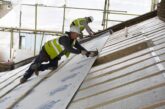
It’s used everywhere, but how much do you know about aircrete? Jenny Smith-Andrews, Marketing Manager at H+H sets a few questions just to check.
Does it float?
Actually yes. Despite their credentials as a weightbearing structural material, aircrete blocks do actually float – because of the thousands of tiny air bubbles captured within the material. It will still hurt if you drop on your foot though.
Can I cut it?
Again yes. Unlike dense concrete or other lightweight aggregate blocks, you can cut aircrete blocks with a handsaw on site. Very handy for tricky details and for irregular shaped extensions.
![]()
Can I use it sub-ground?
Absolutely. Aircrete is resistant to moisture and sulfates, which means that it is very suitable for foundations. Look out for Foundation Blocks in Standard or High-Strength grade which are capable of supporting building up to three storeys tall.
Will it meet Part L of the Building Regulations?
Aircrete’s inherent thermal efficiency – largely down to those air bubbles – means that it has always been a good choice to build external walls that need to meet the energy efficiency standards of Part L.
And yes, Part L is due to be revised – in fact, the new standard should have been introduced this year. If the new version is as we expect, then a cavity wall construction using aircrete blocks will still be a great choice.
If aircrete blocks are used with the Thin-Joint System, then the wall will also provide outstanding air-tightness, making this a great option for Passivhaus construction.
Is it sustainable?
More and more specifiers and homeowners are concerned about the sustainability of the materials they use. H+H aircrete is made using Pulverised Fuel Ash – a legacy waste product from decades of coal-fired energy generation. It’s a great re-use for a material that would otherwise be left in landfill sites around the country.
More to the point, aircrete doesn’t burn, rot or warp. An aircrete structure should have a lifespan of well over 100 years.
Is it a Modern Methods of Construction solution?
It’s difficult to avoid talk of Modern Methods of Construction (MMC) and government is doing as much as it can to encourage developers and housebuilders to use them.
Both the Thin-Joint System and aircrete panels (ours are branded Celcon Elements) are defined as MMC. This means that MMC builds are still based on a familiar material – which is good news for the follow-on trades who will know exactly how to treat it.
![]()
Is it available?
There has been a lot of talk of product supply issues since the Coronavirus pandemic and lockdown caused some supply chain problems. Aircrete is manufactured in the UK and the product is readily available through merchants.
Is it easy to find out about?
Much more technical information about performance, installation methods and applications is freely available on websites, via our own H+H online academy or on You tube.
To find our more about the range of products from H+H visit hhcelcon.co.uk/
There are a number of ‘How To’ videos available on aircrete. To access these visit youtube.com/user/hplushuk







